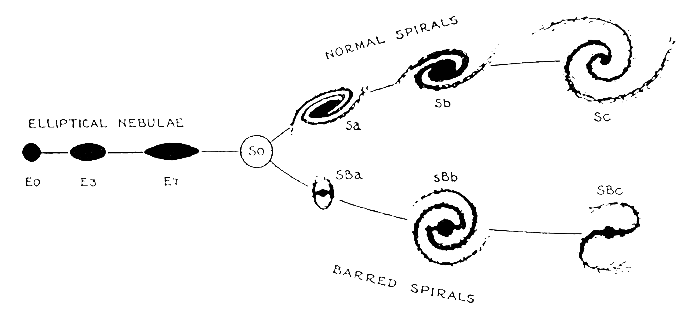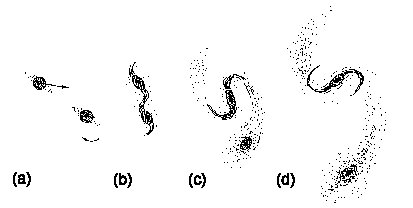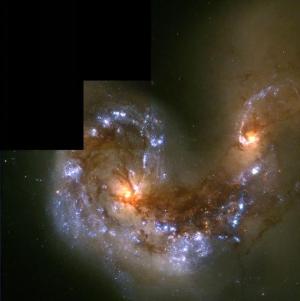 |
However, mergers are not confined to exotic circumstances in history; if we look at the local Universe, there are numerous examples of disturbed galaxies that quite obviously point to galaxy interactions. Such a view was not always held; for many years, right up until the early 1970's, many held the opinion that simple gravity acting on stars could not produce the observed features - bridges and tails being the prime examples - of the peculiars.
The true nature of our Galaxy and the Universe was resolved by Edwin Hubble. Using the 100 m Hooker telescope he was able to gauge the distance to Cepheids in M31, the Andromeda Galaxy; this distance was greater than that proposed by Shapley for the dimensions of our Galaxy and thus M31 must lie beyond its boundaries, a galaxy in its own right.
Hubble is perhaps better known for his observations which demonstrated that the Universe is expanding (borne out in the by now infamous Hubble Law), but he was also responsible for another important development of extragalactic astronomy - the Hubble Sequence. It should not be surprising that Hubble spent many years surveying thousands of galaxies, and during the course of his work, he noticed a trend - galaxies could be ordered into a sequence based on their morphology, the so called Hubble Sequence, an illustration of which is shown below.
 |
On the left hand side of the diagram, which is commonly called a Tuning Fork diagram, we have the ellipticals which range from E0 up to E7 based on their ellipticity. E0s are spherical and ball like while an E7 is shaped like a rugby ball. At the vertex we have the S0s, lenticulars - galaxies which have disks like spirals but unlike spirals are gas poor. Then we branch out into the spirals, Sa, Sb and Sc and the barred spirals, SBa, SBb and SBc.
The obvious question to ask is why the dichotomy of shapes among galaxies? An obvious answer would lie in the formation of galaxies, and indeed, the ELS (Eggen, Lynden-Bell, Sandage) hypothesis [3] seemed to offer a solution. Stars in ellipticals formed far earlier and more quickly during the initial collapse of a primoridal gas cloud that would form the galaxy than their counterparts in spirals. However, this now introduced the question, why should this be so? It is at this point that the importance of galaxy mergers becomes clear.
Lindblad (1926) [7] further theorized that "sharp encounters between nebulae...must be considered as highly inelastic and must tend to convert translational (i.e. orbtial) into rotational (i.e. internal) kinetic energy. An encounter of this kind may even lead to a fusion of the respective bodies."
Unfortunately for Holmberg, there is a fundamental problem with this hypothesis; when the probability for an encounter is estimated, we find that only one galaxy in ten thousand will have had sufficient time to be tidally captured during the lifetime of the Universe, quite at odds with observations.
Despite this, it is interesting to follow Holmberg's experiments into tidal capture of galaxies during close encounters [8]. These were numerical experiments in which each galaxy was modeled as 37 mass points arranged in concentric circles traveling around a common centre. What perhaps was most ingenious about this arrangement was that the mass points were represented by light bulbs! By using the inverse square behaviour of light, Holmberg had uncovered a method to mimic gravitational forces - this was the most computationally intensive part of the problem. Photocells were used to detect the magntiude and direction of the "gravitational force", i.e. the light, and so it was possible to map the trajectories of the mass points by graphical integration.
Holmberg simulated planar encounters between disk galaxies using this technique; he was able to estimate the efficiency of tidal capture for a variety of approach velocities, rotations and minimum separations. Whatsmore he correctly noted that the maximum tidal distortion occurs after the passage of the interloper through pericenter. However, he did not report any problems with bar instabilities, something which should have plagued such a cold disk, and he also noted that tidal capture was most efficient during retrograde passages when the disks counterrotated in an opposite sense to their orbital motion. As noted in Barnes (1996) [9], this is "curious".
In addition to the hyperbolic passages, Holmberg did investigate parabolic encounters and used them to illustrate tidal deformations, but because of the number of mass points involved and the approximations made, felt that this was not sufficient for a detailed study of tidal response. Hence an opportunity was missed to uncover the tidal origins of bridges and tails.

Inspired by both Zwicky's sketches and faint images of peculiar and distorted galaxies, such as those of Vorontsov Velyaminov, Halton Arp spent four years photographing many such objects with the Palomar 200 inch. He believed that "the peculiarities...represent perturbations, deformations and interactions which should enable us to analyze the nature of real galaxies which we observe and which are too remote to experiment on directly". In 1966, he published his Atlas of Peculiar Galaxies, containing high resolution images of 338 systems [12].
This was followed in the early 1970's by a spate of papers, but one in particular stands out. Galactic Bridges and Tails by Toomre and Toomre (1972) is seen as many as the seminal paper in the field of galaxy interactions and mergers. Although it was not unusual at this time for a paper to be published that dealt with computer modeling on interacting galaxies, what separates TT from other papers is
| N-Body Simulations of the Antennae |  |